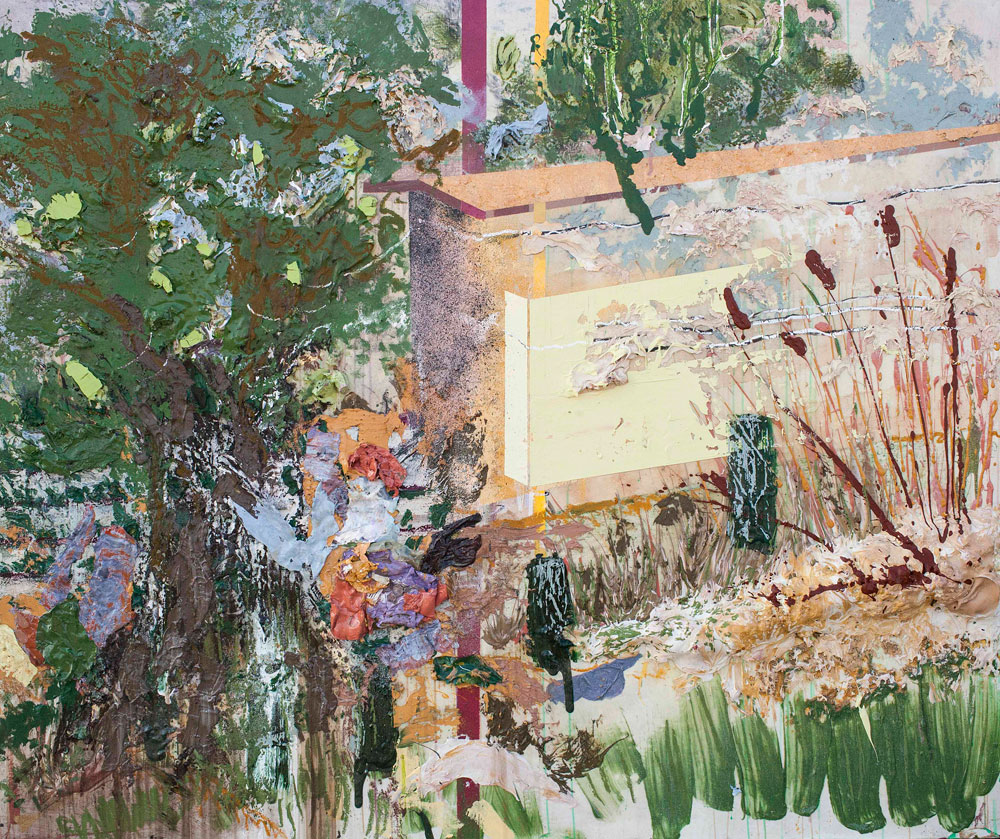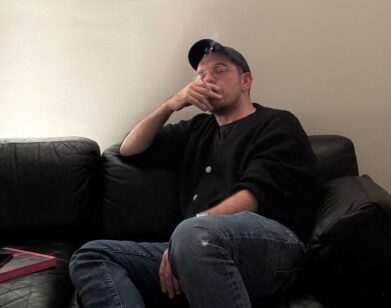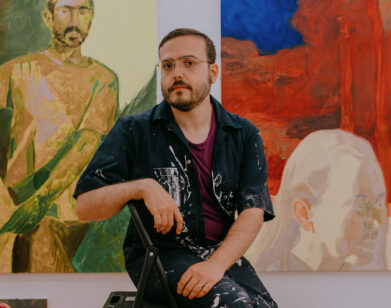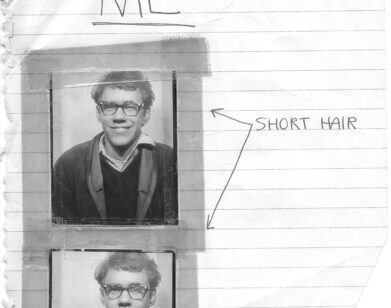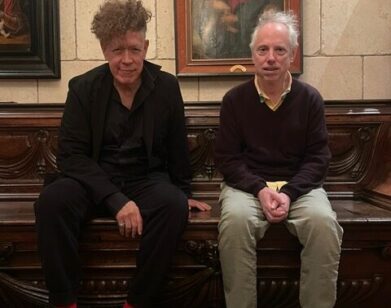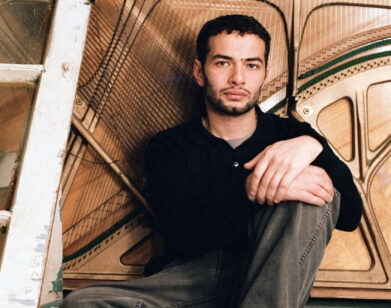Drive By
AIDA MAHMUDOVA IN NEW YORK, MAY 2015. PORTRAITS BY CARL J ASQUINI. SPECIAL THANKS: KODAK ALARIS.
After studying at Central Saint Martins in London, Aida Mahmudova returned to her home country of Azerbaijan, just outside the city of Baku. Once there, she founded YARAT Contemporary Art Space in 2008 and YAY Gallery in 2012. An artist in her own right, Mahmudova’s works have been included in exhibitions around the world. Currently, her seascapes are on view in the Vita Vitale group show at the 56th Venice Biennale and her first solo show in the United States, “Passing By…”, opened last week at Leila Heller Gallery in New York.
Exploring ideas of impermanence and memory, “Passing By…” presents eight newly created landscape paintings interspersed with a few sculptural elements. On the back wall of the gallery hangs On my way home, a 16-foot-long canvas covered with a dark gray sky, abstracted trees, and two hardly visible fences. On the ground, just in front of the painting, translucent blue glass bricks extend a fence outward into the viewer’s space. So while this series depicts landscapes, rather than photorealist reproductions or calm contemplations, Mahmudova’s images exude energy and emotion, appearing like impasto interpretations of scenes witnessed while quickly driving by. Although she has previously delved into the rapidly changing aspects of Baku, here she focuses on scenery from rural Azerbaijan, and coincidentally, the exhibition opened on the country’s independence day.
EMILY MCDERMOTT: Congratulations on your first show in the United States.
AIDA MAHMUDOVA: Thank you. It feels great. The last time I came to New York was about six years ago. I’m scared of flying, so I don’t come often. But this time I came, and now I have to come back. It’s very different than in Europe. There’s a different sense of life and scale and relationships with people; they’re very open. For being such a big city, it has a sense of lightness and happiness.
MCDERMOTT: I saw YARAT’s commission in Venice and the two artists showing were very powerful. I want to talk about how you balance running such a large organization while also producing your own work.
MAHMUDOVA: The main reason why YARAT was founded is because I’m an artist. I wanted to create something where people would unite and work together and help contemporary art in Azerbaijan develop. Being an artist and understanding art from a different perspective, when I started YARAT I wasn’t just the person who founded the organization; I was part of the community. Then I founded the gallery [YAY Gallery] two years later. The Center for Contemporary Arts opened in March with Shirin Neshat on the second floor and the first floor the permanent collection. The space will change every year.
At the same time, I’ve been working on my own art. On one side, it works well because what we do is art and what I do is art, then I put it together. But from another point of view it’s difficult because of time and energy. The first two years, I think I slept for two hours. I would go out during the day, work on YARAT and exhibitions, and at night I would paint. Since it was initially a group of artists, I would communicate with artists and be around art. That helped me in my personal work, to develop and move forward.
We inspired each other, but at the same time you have your personal world that you develop. For the past year, I’ve concentrated on my own art. Most of the time I spend in the studio, and maybe twice a week I go to the office. If I go to the office, I can’t go to the studio the same day because I don’t feel anything. I can’t concentrate.
MCDERMOTT: What’s the studio like for you?
MAHMUDOVA: I work on about three or four paintings at a time and now I’m doing more large-scale paintings. It gives me more freedom. At some point I was doing quite small ones, and then suddenly I moved to very large canvases. I don’t know why. Maybe at the time I needed a freedom of movement. When it’s small scale, it becomes monotone and too precise. When it’s large scale, I use my hands most of the time. I don’t even use brushes. I use the roller to do the base, but the rest is hands. I do the magic with my hands; it’s like cooking, and I love to cook as well. I like to use my hands; you pass your energy and you get the energy back. It’s a close, physical contact. It’s about what you feel.
MCDERMOTT: Do you feel the process is as important as the finished work?
MAHMUDOVA: Process for me is more important. The process is a relationship. It takes me sometimes three or four months to make a painting. There’s a lot of conflict and love, all together. There’s a sense of sadness in it. At the same time, you can’t judge it when you look at it. These [paintings in the show], I haven’t seen them in one month, and now I look at them differently.
MCDERMOTT: So how do you know when to stop the process?
MAHMUDOVA: Sometimes I stop because I feel like there’s nothing I can do and it won’t get me anywhere further. I’ve ruined a lot of paintings. About 50 percent of my paintings I ruin and cover on top. There’s two paintings here that underneath, there’s three or four different images that I covered, and covered, and covered, and covered… I cry a lot when I paint. The main purpose of painting is for me to be able to pass my emotions, feelings, and state of mind that I’m at in that moment. The image is important, of course, a lot of people tell me, “You make landscapes. It’s very pretty,” but that’s not the point.
MCDERMOTT: You’re addressing the change.
MAHMUDOVA: And the slow change. The architecture and Azerbaijan—it’s fast change. But this series is more based on the outskirts of the city and the landscapes. The idea is more about universal time, rather than time in Azerbaijan. The landscapes, they shift slowly and it’s based on the images that I pass by when I’m in the car.
MCDERMOTT: Do you take photos and paint from those?
MAHMUDOVA: I take pictures, but they’re not from pictures. I’ll look at them on my phone, but it restricts me from what I want to do on the painting. The painting comes from my head. The movement of a brushstroke or a hand-stroke—the strokes, the color combination, the balance between colors, the composition—is all created during the process. I’m trying to express feelings through that, not through the actual image. Nature is the most inspiring thing for me. I love nature; I recharge when I’m in nature. It has colors and movement and a lot of personality.
MCDERMOTT: What draws you toward the contemporary changes and landscapes rather than all of the historical references available in Azerbaijan?
MAHMUDOVA: It’s taking the past, present, and future. I also do installations where I use old doors and window frames that were thrown away. So, I always reference [history], but take it to the future in order to freeze the time and make it timeless. It raises questions of how it was in the past, and how fast it’s moving toward the present, and how fast it will move toward the future. The change is taking place in Azerbaijan quite rapidly. People are moving too fast; people are thinking too fast; there’s too much information. Sometimes I feel like my head’s going to explode, and it’s the same with the city; it’s exploding and exploding. It’s good, it’s progress, but at the same time, it’s important to keep the culture.
MCDERMOTT: What are some of the biggest changes you’ve seen or experienced that really inspired you?
MAHMUDOVA: Internal changes come quite often. It’s interesting to have experiences inside and then look back and realize you’re a different person. It’s unbelievable how fast it happens, and how you don’t realize it is happening. One of the biggest changes was giving birth to my daughter. Obviously there are a lot of external factors, a lot of things happened and will happen, but this was the most significant one. It put my life upside down in one day. That’s when I became a woman; I didn’t understand that until I had my own child. The first year was very difficult for me. I has this post-pregnancy depression—the hormones, everything just starts jumping up and down. After, the second year was beautiful. I started understanding where I am and how my life changed. That’s when I founded YARAT.
MCDERMOTT: Were you painting during the first year? What helped you through that?
MAHMUDOVA: I was, but I hate those paintings. I should never show them. But I paint all the time. If I don’t paint I think I’m going to die—literally. It’s something I need to do all the time. It’s like eating or sleeping. If you have a purpose to paint, say an exhibition, then it’s great because you have an aim and prepare for it, but even if you don’t, it’s an urge you cannot control.
MCDERMOTT: When you’re making paintings for an exhibition, do you see them individually or as a whole?
MAHMUDOVA: It’s like having five or 10 kids—it’s one big family, but each one of them is individual and all have different characters.
MCDERMOTT: During your childhood, how did you first become interested in art?
MAHMUDOVA: As long as I remember I was making art. I went to an art school for kids. If you go to a normal school [in Azerbaijan], there’s no art, no music. So I continued art courses the same time I went to normal school.
MCDERMOTT: What was one of the first pieces you made that you were satisfied with?
MAHMUDOVA: I remember, as a small kid when I used to attend those courses, I made a big painting of lilac flowers. My grandma hung it in my room and I used to look at it every day. I was very proud. But all the small moments create this one big picture of where you are at, what you’ve become—it’s everything, it’s my family, not just my art practice. You should build out until you stop as an artist. I guess, at some point, you feel you’re making no progress and that’s when I will stop completely. I don’t want to hold on. You should never hold on to things.
MCDERMOTT: It’s interesting you say that you shouldn’t hold on to things, because so many of the works are about freezing a moment and kind of holding on…
MAHMUDOVA: You know when you take picture of you and your family and it’s in your house? It’s a good memory of something that happened, but you can let go of [it]. I’m actually releasing on the paintings—it’s more of a freedom and release than holding on.
“PASSING BY…” IS ON VIEW AT LEILA HELLER GALLERY IN NEW YORK THROUGH JULY 3, 2015. FOR MORE ON THE ARTIST AND YARAT, VISIT ITS WEBSITE.

